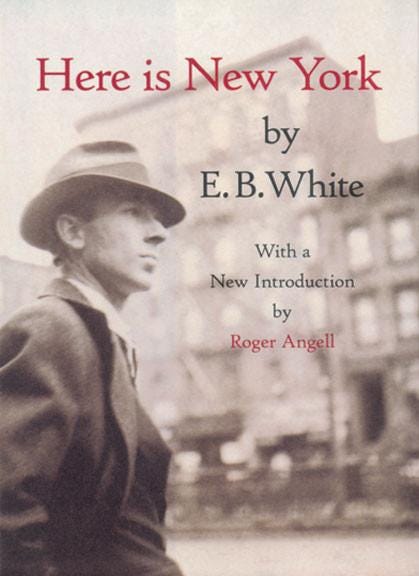
Here is New York is a long essay written by EB White. It is, as the title suggests, about New York. It was written in the summer of 1948 during a hot spell as mentioned in the Foreword by the author.
White was one of the early staff writers of The New Yorker magazine. His name became synonymous with the magazine as the years progressed. He is considered one of the leading essayists of America. He also wrote children’s books - Stuart Little, Charlotte’s Web, and The Trumpet of Swan.
Here is New York talks about the idiosyncrasies of the city back in the day. It is not so much the observations that would interest a reader today, as she has been exposed to many such books written on many other cities, but the way they are put to language. It makes one feel a strange familiarity with the city that no longer exists and is highly likely to not exist in the future. What is written about New York rings true for most of the metropolitan cities one has been to -
A poem compresses much in a small space and adds music, thus heightening its meaning. The city is like poetry: it compresses all life, all races and breeds, into a small island and adds music and the accompaniment of internal engines.
Even for someone who has never been to New York, the crisp prose makes it easy to imagine the internal engines White is referring to. What he says about poetry can be said about his sentences too. They pack so much into them without sounding awkward or cluttered. This scene when he is describing a slum for example -
It is folksy here with the smell of warm flesh and squashed fruit and fly-bitten filth in the gutter, and cooking.
It is not an exposition of but a meditation on the city. While describing some aspects of it, White sometimes breaks into interludes that explore themes not specific to New York - loneliness, love, poverty, prosperity and so on. Though these interludes are never more than a couple of sentences long, they still manage to make one think hard. The most succinct one is quoted below (italics mine) -
Money has been plentiful and New York has responded. Restaurants are hard to get into; businessmen stand in line for a Schrafft’s luncheon as meekly as idle men used to stand in soup lines. (Prosperity creates its bread lines, the same as depression.)
This book is a delight for readers who are interested in cities and more importantly, in meditative lean prose. White also happens to be the co-author of one of the most famous style guide for writers - The Elements of Style.
For people who write on Substack, please consider recommending Mehfil if you enjoy reading the posts. Thank you.




